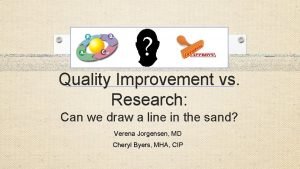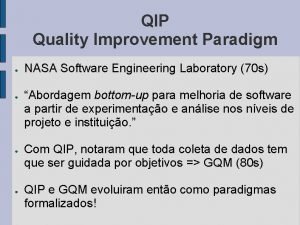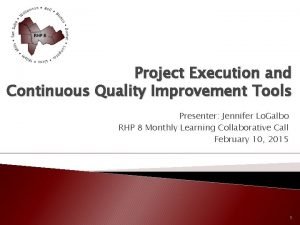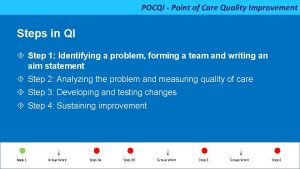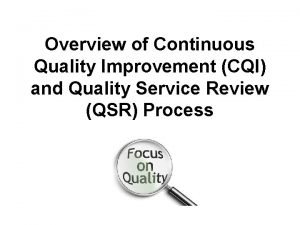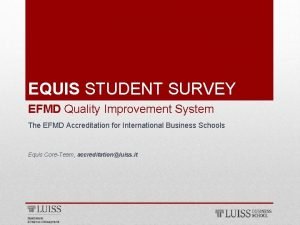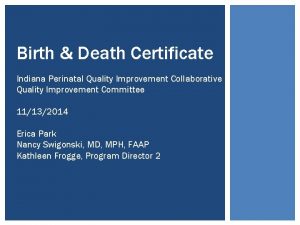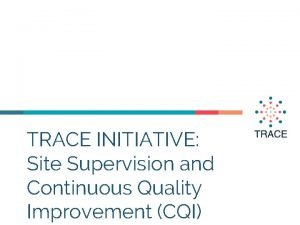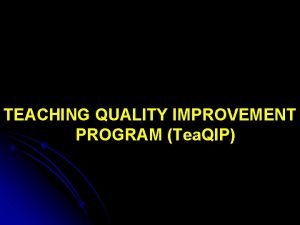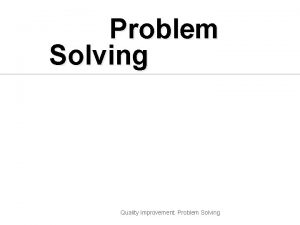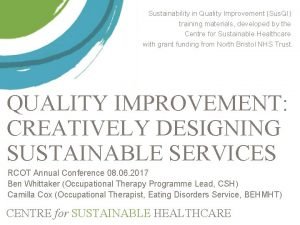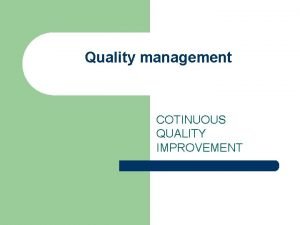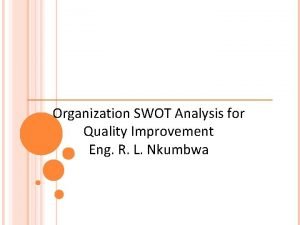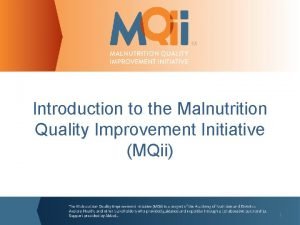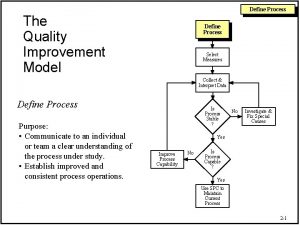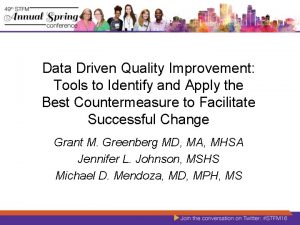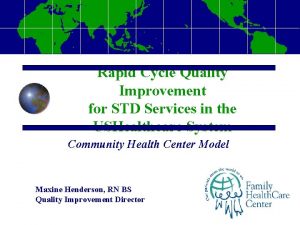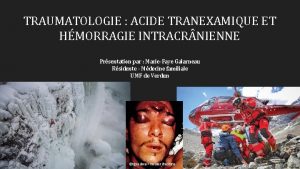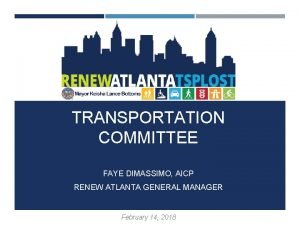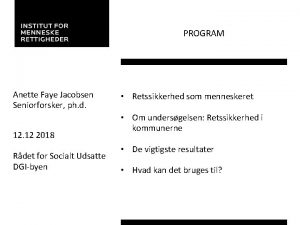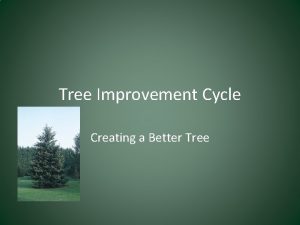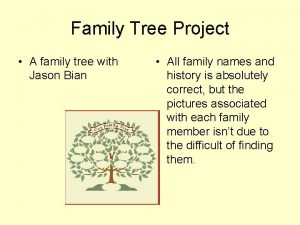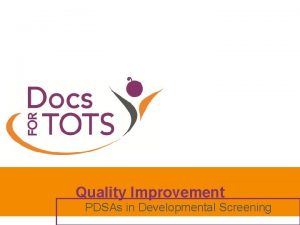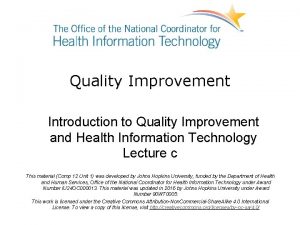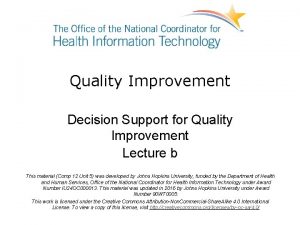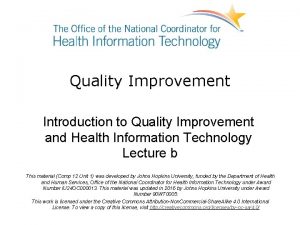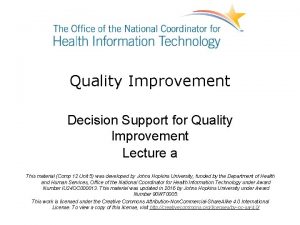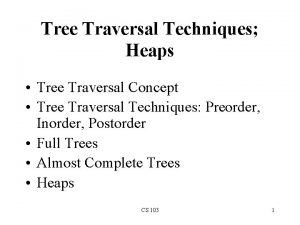The Family Tree of Quality Improvement Faye Nipps







































































- Slides: 71

The Family Tree of Quality Improvement Faye Nipps, MBA, BSN, CPHQ

Objectives § Clarify knowledge of the Transition of Health and Care in America § Identify three strategies to improve cardiac health through Best Practice Intervention Packages (BPIPS) and Home Health Quality Improvement (HHQI) § Communicate assistance provided for home health agencies (HHAs) on improving influenza, pneumococcal and herpes zoster immunization rates, reducing hospital readmissions and improving medication safety § Provide resources for data-driven performance improvement from HHQI and the TMF Quality Innovation Network Quality Improvement Organization (QIN-QIO) 2

The Centers for Medicare and Medicaid Services 3

Family Tree of HHQI Note: the Million Hearts® word and logo marks are owned by the U. S. Department of Health and Human Services (HHS). Use of these marks does not imply endorsement by HHS. Use of the Marks also does not necessarily imply that the materials have been reviewed or approved by HHS. 4

2014 Success

The Triple Aim – CMS QIN-QIO Approach to Clinical Quality Goals National Patient Safety Foundational Principles § § Enable innovation Foster learning organizations Eliminate disparities Strengthen infrastructure and data systems § Make care safer § Strengthen person and family engagement § Promote effective communication and coordination of care § Promote effective prevention and treatment § Promote best practices for healthy living § Make care affordable 6

7

Our Heritage Source: CMS QIO Program Documentary, https: //www. youtube. com/watch? v=jbq. Ul. RRm. Qgs 8

TMF QIN-QIO 9

11 th Statement of Work (SOW) QIN-QIO Map 10

About the QIN-QIO Program Leading rapid cycle, large-scale change in health quality: § Goals are bolder. § The patient is at the center. § All improvers are welcome. § Everyone teaches and learns. § Greater value is fostered. 11

Four Key Roles of the QIN-QIO § Champion local-level, results-oriented change › Data-driven › Active engagement of patients and other partners › Proactive, intentional innovation and spread of best practices that stick § Facilitate Learning and Action Networks (LANs) › Create an all-teach, all-learn environment › Place impetus for improvement at the bedside level (e. g. , handwashing) § Teach and advise as technical experts › Consultation and education › The management of knowledge so learning is never lost § Communicate effectively › Optimal learning, patient activation and sustained behavior change 12

TMF QIN-QIO Website www. tmfqin. org § Provides targeted technical assistance and engages providers and stakeholders in improvement initiatives through numerous LANs. § The networks serve as information hubs to monitor data, engage relevant organizations, facilitate learning and sharing of best practices, reduce disparities and elevate the voice of the patient. 13

LANs Join any of the following TMFQIN. org networks and you can sign up to receive email notifications to stay current on announcements, emerging content, events and discussions in the online forums. § Cardiovascular Health and Million Hearts § Health for Life – Everyone with Diabetes Counts § Healthcare-Associated Infections § Meaningful Use § Medication Safety § Nursing Home Quality Improvement § Patient and Family § Quality Improvement Initiative § Readmissions § Value-Based Improvement and Outcomes 14

All Are Welcome § To join, create a free account at www. tmfqin. org. Visit the Networks tab for more information. § As you complete registration, follow the prompts to choose the network(s) you would like to join. § Choose the Readmission Network and set up a data portal account to view your agencies’ readmission reports if you are in a QIN-QIO-recruited coalition. 15

Care Coordination § Readmission Network § Medication Safety Network

TMF QIN-QIOs Provide technical assistance with: § Community coalition formation § Root cause analyses § Intervention selection and implementation plan § Measurement § Readmission and medication safety metrics § Educational webinars § Open Forum calls 17

Communities § ACT › › East ACT Delta ACT North Central ACT* Northwest ACT* § Oklahoma › › › › Lawton Norman Hugo Durant Mc. Alester* Clinton* Oklahoma City* § Missouri › › › West Central Kansas City* St. Louis* § Puerto Rico › › LAZO CUPRI* § Texas › › › Denton El Paso Lubbock Rio Grande Valley, Upper Rio Grande Valley, Lower Lufkin/Nacogdoches Temple/Waco Sherman Houston* Dallas* Ft Worth* Laredo* * Recruiting in 2015

TMF QIN-QIO Goals for Care Coordination and Medication Safety Project § Improve care transitions for Medicare Fee-for-Service (FFS) beneficiaries by recruiting and working with community coalitions § Improve medication safety and reduce adverse drug events (ADEs) for Medicare FFS beneficiaries in the region § Special emphasis on these sub-groups of Medicare FFS beneficiaries: › › › Dual eligible Multiple chronic conditions with multiple at-risk medications Behavioral health issues Alzheimer’s disease and dementia Lower socioeconomic status and other social determinates of health 19

Statement of Problem: Readmissions § Hospitalizations consume 31 percent of $2 trillion in total health care expenditures in the United States › 1 in 4 hospitalizations (25 percent) are avoidable › 1 in 5 hospitalizations (20 percent) result in 30 -day readmissions Source: Lynn J, Straube BM, Bell KM, Jencks SF, Kambic RT. Using population segmentation to provide better health care for all: The “Bridges to Health” model. Milbank Q. 2007; 85: 185 -208. 20

Readmissions Network Goals § Reduce hospital readmission rates in the Medicare program by 20 percent § Reduce hospital admission rates in the Medicare program by 20 percent § Increase community tenure by increasing the number of days spent at home by Medicare FFS beneficiaries by 10 percent § Reduce the prevalence of adverse drug events, emergency department visits and observation stays or readmissions occurring as a result of the care transitions process 21

What is an unplanned readmission? § A hospitalization within 30 days of discharge that was not foreseen at discharge § Almost always urgent or emergencies § Often signal failure of the transition from hospital to another source of care 22

Quick Facts § In October 2013, Medicare reduced reimbursement by up to 2 percent for 2, 225 hospitals due to excess readmissions. § The payment penalty for readmissions increased to 3 percent in October 2014. § Med. PAC recommendation: adjust skilled nursing facility (SNF) payments to reduce hospital readmissions. > This proposal reduces payments by up to 3 percent for SNFs with high rates of care-sensitive, preventable hospital readmissions, beginning in 2017. > This will accrue $2. 2 billion in savings over 10 years. > Med. PAC estimates 14 percent of SNF readmissions are preventable. 23

Statement of Problem: Medication Safety § National estimates suggest that ADEs contribute an additional $3. 5 billion dollars to U. S. health care costs. 1 § Given the U. S. population’s large and ever-increasing magnitude of medication exposure, the potential for harm from ADEs is a critical patient safety and public health challenge. § ADEs are a direct result of drugs used during medical care that produce harmful events. These harmful events can include, but are not limited to, medication errors, adverse drug reactions, allergic reactions and overdoses. 2, 3 1 Institute of Medicine Committee on Identifying and Preventing Medication Errors: Quality Chasm Series. Washington, DC: The National Academies Press, 2006. 2 Agency for Healthcare Research and Quality. Adverse Drug Event (ADE), in Patient Safety Network: Glossary. Available at: http: //psnet. ahrq. gov/glossary. aspx. 3 National Action Plan for Adverse Drug Event Prevention. U. S. Department of Health and Human Services, Office of Disease Prevention and Health Promotion, 2013. 24

Research Shows § 80 percent of patients will forget what their providers say § Almost 50 percent of what patients remember is recalled incorrectly § Health literacy costs health care systems as much as $58 billion/year § 33 percent of patients are unable to read basic health care material § 42 percent of patients do not understand directions for taking medications on an empty stomach Source: HHQI Best Practice Intervention Package: underserved populations 25

Medication Safety Network § Reduce ADEs by 35 percent per 1, 000 screened Medicare FFS beneficiaries by the year 2019 § Monitor ADE rates by Medicare FFS beneficiaries on anticoagulants, diabetic agents or opioids by care setting, state, region and readmission rate 26

What causes ADEs in the elderly? Research shows: § § Among older adults (65 years of age or older), 57 -59 percent reported taking five to nine medications, while 17 -19 percent reported taking 10 or more. 1 ADEs can occur in any health care setting, including inpatient (e. g. , acute care hospitals), outpatient and long-term care settings (e. g. , nursing homes). § The likelihood of ADEs occurring may also increase during transitions of care (transitions from one health care setting to another) when information may not be adequately transferred among health care providers, 2 or patients may not completely understand how to manage their medications. 3, 4, 5 1 Slone Epidemiology Center. Patterns of medication use in the United States: A report from the Slone Survey. Boston, MA: 2006. S, Le. Fevre F, Phillips CO, Williams MV, Basaviah P, Baker FW. Deficits in communication and information transfer between hospital-based and primary care physicians: implications for patient safety and continuity of care. JAMA. 2007; 297(8): 831 -41. 3 Schnipper JL, Kirwin JL, Cotugno MC, et al. Role of pharmacist counseling in preventing adverse drug events after hospitalization. Arch Intern Med. 2006; 166(5): 565 -71. 4 Calkins DR, Davis RB, Reiley P, et al. Patient-physician communication at hospital discharge and patients’ understanding of the post-discharge treatment plan. Arch Intern Med. 1997; 157(9): 1026 -30. 5 Lindquist LA, Go L, Fleisher J, Jain N, Friesema E, Baker DW. Relationship of health literacy to intentional and unintentional non-adherence of hospital discharge medications. J Gen Intern Med. 2012; 27(2): 173 -8. 2 Kripalani 27

What causes ADEs in the elderly? Research shows: § In inpatient settings, ADEs are the single largest contributors to hospital-related complications. 7 ADEs comprise an estimated one-third of all hospital adverse events, 8 affect approximately 2 million hospital stays annually 8, 9 and prolong hospital length of stay by approximately 1. 7 to 4. 6 days. 9, 10, 11 § ADEs have also been identified as the most common causes of postdischarge complications (those occurring within three weeks of hospital discharge), accounting for two-thirds of all post discharge complications – more than half of which are likely preventable. 12 7 Classen DC, Resar R, Griffin F, et al. ‘Global trigger tool’ shows that adverse events in hospitals may be ten times greater than previously measured. Health Aff (Millwood). 2011; 30(4): 581 -9. Department of Health and Human Services Office of Inspector General (OIG). Adverse Events in Hospitals: National Incidence Among Medicare Beneficiaries. Washington, DC. , 2010 November. Report No. : OEI-06 -09 -00090. 9 Lucado, J. (Social & Scientific Systems, Inc. ), Paez, K. (Social & Scientific Systems, Inc. ), and Elixhauser A. (AHRQ). Medication-Related Adverse Outcomes in U. S. Hospitals and Emergency Departments, 2008. HCUP Statistical Brief #109. April 2011. Agency for Healthcare Research and Quality, Rockville, MD. Available from: http: //www. hcupus. ahrq. gov/reports/statbriefs/sb 109. pdf. 10 Bates DW, Spell N, Cullen DJ, et al. The costs of adverse drug events in hospitalized patients. Adverse Drug Events Prevention Study Group. JAMA. 1997; 277(4): 307 -11. 11 Classen DC, Pestotnik SL, Evans RS, Lloyd JF, Burke JP. Adverse drug events in hospitalized patients. Excess length of stay, extra costs, and attributable mortality. JAMA. 1997; 277(4): 301 -6. 12 Forster AJ, Murff HJ, Peterson JF, Gandhi TK, Bates DW. The incidence and severity of adverse events affecting patients after discharge from the hospital. Ann Intern Med. 2003; 138(3): 161 -7. 8 U. S. 28

Hospital VBP FY 2017 Domains 29

Improving Medicare Beneficiary Influenza, Pneumococcal and Herpes Zoster Immunization Rates 30

Immunization Project Objectives Improve: § Tracking § Assessment and documentation § Reporting Special focus: § Reducing immunization health care disparities 31

Discussion Question Influenza and pneumonia are ranked what number as the top 10 leading cause of death? a. 7 th leading cause b. 5 th leading cause c. 8 th leading cause 32

Influenza and Pneumonia: Eighth-Leading Cause of Death Source: CDC/NCHS, National Vital Statistics System, Mortality 33

Deaths from Pneumonia 53, 282 Sources: http: //www. cdc. gov/nchs/data/nvsr 64/nvsr 64_02. pdf; 34

Deaths from Influenza 65 years and older Less than 65 years 90% 35

Discussion Question What percentage of Medicare beneficiaries are vaccinated for influenza? a. 60 percent b. 54 percent c. 49 percent 36

Percentage of Medicare Beneficiaries Vaccinated 100 90 80 70 60 50 40 30 20 10 0 60% 54% Pneumoccocal Influenza Pneumoccocal Source: Centers for Disease Control and Prevention. (2014). Interactive mapping tool: Live-tracking flu vaccinations of Medicare beneficiaries; Williams, W. W. , Lu, P-J. , O’Halloran, A. , Bridges, C. B. , Pilishvili, T. , Hales, C. M. , & Markowitz, L. E. (2014). Noninfluenza vaccination coverage among adults. United States, 2012. Morbidity and Mortality Weekly Report, 63(5), 95 -102 37

Herpes Zoster 1 million cases Varicella / Shingles Source: http: //www. cdc. gov/vaccines/vpd-vac/varicella/rationale-vacc. htm 100% effective Herpes Zoster Vaccine 20% Vaccinated 38

39

Influenza Vaccination 100 90 80 70 60 50 40 30 20 10 0 59% Received at Physician Office 100 90 80 70 60 50 40 30 20 10 0 54% Medicare Beneficiaries Vaccinated Source: Centers for Disease Control and Prevention. (2014). Interactive mapping tool: Live-tracking flu vaccinations of Medicare beneficiaries; Williams, W. W. , Lu, PJ, O’Halloran, A. , Bridges, CB, Pilishvili, T. , Hales, C. M. , & Markowitz, L. E. (2014). Centers for Medicare and Medicaid Services. Overview Medicare Current Beneficiary Survey. 2011 a Retrieved from http: //www. cms. gov/mcbs/ 40

Discussion Question What racial/ethnic group has the lowest rates for influenza vaccinations? a. White b. Asian c. Black d. Hispanic 41

Medicare Immunization Rates by Type, Race and Ethnicity 64 % 41 % Pneumococcal 46. % 43. % 71 % 56 % Influenza 55 % 34 % White Asian Black Hispanic 23 % Zoster 17 % 9% 9% 0 10 20 30 40 50 60 70 80 90 100 Source: Centers for Disease Control and Prevention. (2014). Interactive mapping tool: Live-tracking flu vaccinations of Medicare beneficiaries; Williams, W. W. , Lu, P-J. , O’Halloran, A. , Bridges, C. B. , Pilishvili, T. , Hales, C. M. , & Markowitz, L. E. (2014). Noninfluenza vaccination coverage among adults – United States, 2012. Morbidity and Mortality Weekly Report, 63(5), 95 -102 42

2019 Goals § Align with the Healthy People 2020 Goals › National Absolute Immunization Rates • 70 percent influenza • 90 percent pneumonia • 30 percent zoster § 1 million previously unimmunized Medicare beneficiaries will receive pneumonia immunization § 90 percent of adult immunizations will be reported to the registry 43

Recruitment: Health Care Providers § § § Physician Offices Hospitals Critical Access Hospitals HHAs Pharmacies Vaccination Centers 44

Recruitment: Community § § § Community Organizations Physician Organizations State/Territory Agencies State/Territory Immunization Registries Beneficiary Representatives 45

Technical Assistance Collaborate with HHAs and provide technical assistance on: § Improving cardiac health through BPIPS § Improving immunization rates for influenza, pneumococcal and herpes zoster diseases § Reducing hospital readmissions § Improving medication safety 46

Technical Assistance, cont. § Educating patients, staff, physicians § Standing orders and protocols § Electronic health record and paper chart: reminder/recall systems § Flu-Fit Program (American Cancer Society) § Improving accessibility § Immunization registry reporting § Policy and procedure updates 47

Technical Assistance, cont. § Providing evidence-based practices § Sharing interventions and techniques to increase community demand § Promoting the “Immunization Passport” to improve documentation and communication § Identifying or developing educational tools and resources 48

Proposed Annual Impact 61, 000 Medicare beneficiaries: § Pneumonia vaccination: 5, 850 § Influenza vaccination: 52, 950 § Herpes zoster vaccination: 2, 200 49

IMMUNIZATION REGISTRIES FLU-FIT PROGRAM ENHANCED VACCINATION ACCESS Coordinated Interventions SHARED TOOLS AND BEST PRACTICES EDUCATIONAL PROGRAMS AFFINITY GROUP SESSIONS COMMUNITY VACCINATION CLINICS 50

www. Home. Health. Quality. org 51

Data § Individualized reports: › Acute Care Hospitalization › Oral Medication Management › Immunizations § Securely delivered online § Updated monthly § OASIS-based (raw and risk -adjusted) § Historical trends and target setting 52




Cardiovascular Health Network TMF QIN-QIO 56

Cardiovascular Health Network HHAs Access to resources and literature Expert Consulting Services Assistance focused on the ABCS Benefits HHQI tools and interventions http: //www. tmfqin. org Access to live online forums for networking 57

Cardiovascular Health: Let’s Get to the Heart of the Data The Facts § Heart disease and stroke are the FIRST- and FOURTHleading causes of death respectively for all races in the United States § Annually, heart disease and stroke cost more than $312. 6 billion in health care expenditures and lost productivity Put it into Perspective 1. 5 million people The population of San Antonio Number of HEART ATTACKS and STROKES EACH YEAR in the US 800, 000 people Weekly attendance at Disney World® Number of Americans who 2, 200 people Number of passengers in four loaded jets 58

Cardiovascular Health Network HHAs We help HHAs sign up for the Cardiovascular Data Registry, developed through the HHQI National Campaign. This registry allows HHAs to track progress related to the ABCS (Aspirin therapy, Blood pressure management, Cholesterol control and Smoking/tobacco cessation). Utilize BPIPs to provide technical assistance Utilize health literacy tools to provide education Participate in cardiac LAN Network activities and share success stories 59

Cardiovascular Health Network Technical assistance: § Focus on ABCS § Improving health care delivery § Regional open forums and LANs § CMS incentive payment programs § Patient/provider collaboration § Tools and resources on www. tmfqin. org 60

Cardiovascular Health Network Goals: § Facilitate improvements and best practices § Assist Providers with reporting cardiovascular PQRS reporting § Assist HHAs to report cardiovascular measures through the Home Health Cardiovascular Data Registry (HHCDR) § Improving performance on the following clinical quality measures: > > Aspirin therapy; Blood pressure control Cholesterol control Smoking/Tobacco Use 61


HHCDR § § § § Available to CMS-certified HHAs Helps target potential disparities in care Provides evidence of impact made by improvement efforts Most data auto-populates from OASIS-C transmissions Requires approximately two to three hours per month Option to select which measure/s to abstract: ABCS Twelve patients per measure or total discharges (whichever is smaller) 63

Do You Know Your ABCS? The Million Hearts® word and logo marks are owned by the U. S. Department of Health and Human Services (HHS). Use of these marks does not imply endorsement by HHS. Use of the Marks also does not necessarily imply that the materials have been reviewed or approved by HHS. 64

HHCDR § Was the patient taking ASA? § Final blood pressure? › Was HTN addressed during this episode? § Did the patient have a lipid panel in the record? § Was the patient assessed for tobacco use? › Was it addressed? § Was the patient dually eligible? 65

Cardio Milestones Sign up for the HHCDR Download all cardiovascular BPIPs Complete HHCDR security authentication Close at least one month of required patient data in the HHCDR Download at least one HHCDR report Abstract and close a total of six months of required patient data for HHCDR § Validate data § Achieve noted improvement in one or more cardiovascular outcomes § § § 66

http: //homehealthquality. org 67

BPIPs § Two primary cardiovascular health BPIPs › Aspirin as appropriate and blood pressure control › Cholesterol management and smoking cessation § Fundamental BPIPS focus on: › Blood pressure control › Smoking cessation § § Include patient tools and resources Free nursing continuing education credits available 68

Sign Up Today 69

THE DNA 70

Questions? Faye Nipps, MBA, BSN, CPHQ TMF Quality Innovation Network Phone: 501 -920 -4607 fnipps@afmc. org Faye. Nipps@area-b. hcqis. org This material was prepared by TMF Health Quality Institute, the Medicare Quality Innovation Network Quality Improvement Organization, under contract with the Centers for Medicare & Medicaid Services (CMS), an agency of the U. S. Department of Health and Human Services. The contents do not necessarily reflect CMS policy. 11 SOW-QINQIO-C 3 -15 -57 71
 Quality assurance cycle in nursing
Quality assurance cycle in nursing Compliance vs quality
Compliance vs quality Jhm irb
Jhm irb Qsen quality improvement examples
Qsen quality improvement examples Quality improvement paradigm
Quality improvement paradigm Define continuous quality improvement
Define continuous quality improvement Pocqi ppt
Pocqi ppt Define continuous quality improvement
Define continuous quality improvement Efmd quality improvement system
Efmd quality improvement system Indiana perinatal quality improvement collaborative
Indiana perinatal quality improvement collaborative Continuous quality improvement program planning worksheet
Continuous quality improvement program planning worksheet Tea quality improvement
Tea quality improvement Xerox problem solving process
Xerox problem solving process Sus qi
Sus qi Cotinuous
Cotinuous Quality improvement
Quality improvement Juran 10 steps to quality improvement
Juran 10 steps to quality improvement Swot analysis for quality
Swot analysis for quality Mqii toolkit
Mqii toolkit Quality improvement
Quality improvement Data driven quality improvement
Data driven quality improvement Rapid cycle quality improvement
Rapid cycle quality improvement Quality is free
Quality is free 21 problemas de enfermería
21 problemas de enfermería Marie-faye galarneau
Marie-faye galarneau Faye dimassimo
Faye dimassimo Dr faye dannhauser
Dr faye dannhauser Anette faye jacobsen
Anette faye jacobsen Faye schulman photos
Faye schulman photos Carmen faye mathes
Carmen faye mathes Perform quality assurance
Perform quality assurance Quality management pmp
Quality management pmp Pmp gold plating
Pmp gold plating Quality assurance concepts
Quality assurance concepts Quality guru
Quality guru What is tqm
What is tqm Hình ảnh bộ gõ cơ thể búng tay
Hình ảnh bộ gõ cơ thể búng tay Lp html
Lp html Bổ thể
Bổ thể Tỉ lệ cơ thể trẻ em
Tỉ lệ cơ thể trẻ em Chó sói
Chó sói Tư thế worm breton là gì
Tư thế worm breton là gì Chúa yêu trần thế
Chúa yêu trần thế Các môn thể thao bắt đầu bằng tiếng đua
Các môn thể thao bắt đầu bằng tiếng đua Thế nào là hệ số cao nhất
Thế nào là hệ số cao nhất Các châu lục và đại dương trên thế giới
Các châu lục và đại dương trên thế giới Công thức tính độ biến thiên đông lượng
Công thức tính độ biến thiên đông lượng Trời xanh đây là của chúng ta thể thơ
Trời xanh đây là của chúng ta thể thơ Cách giải mật thư tọa độ
Cách giải mật thư tọa độ 101012 bằng
101012 bằng độ dài liên kết
độ dài liên kết Các châu lục và đại dương trên thế giới
Các châu lục và đại dương trên thế giới Thể thơ truyền thống
Thể thơ truyền thống Quá trình desamine hóa có thể tạo ra
Quá trình desamine hóa có thể tạo ra Một số thể thơ truyền thống
Một số thể thơ truyền thống Cái miệng nó xinh thế chỉ nói điều hay thôi
Cái miệng nó xinh thế chỉ nói điều hay thôi Vẽ hình chiếu vuông góc của vật thể sau
Vẽ hình chiếu vuông góc của vật thể sau Thế nào là sự mỏi cơ
Thế nào là sự mỏi cơ đặc điểm cơ thể của người tối cổ
đặc điểm cơ thể của người tối cổ V. c c
V. c c Vẽ hình chiếu đứng bằng cạnh của vật thể
Vẽ hình chiếu đứng bằng cạnh của vật thể Tia chieu sa te
Tia chieu sa te Thẻ vin
Thẻ vin đại từ thay thế
đại từ thay thế điện thế nghỉ
điện thế nghỉ Tư thế ngồi viết
Tư thế ngồi viết Diễn thế sinh thái là
Diễn thế sinh thái là Dot
Dot Số nguyên là gì
Số nguyên là gì Tư thế ngồi viết
Tư thế ngồi viết Lời thề hippocrates
Lời thề hippocrates Thiếu nhi thế giới liên hoan
Thiếu nhi thế giới liên hoan


